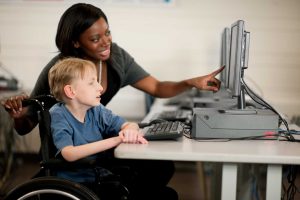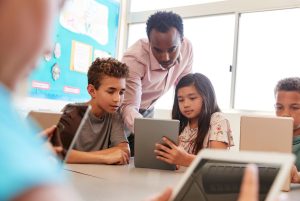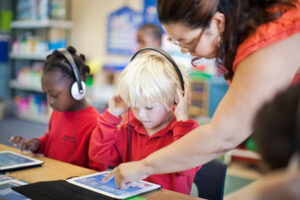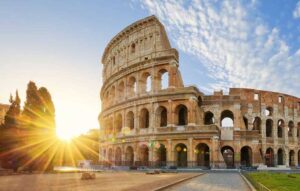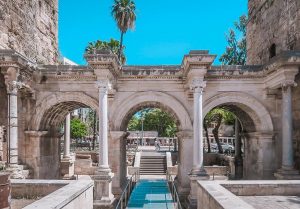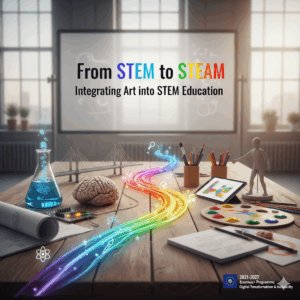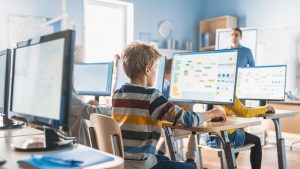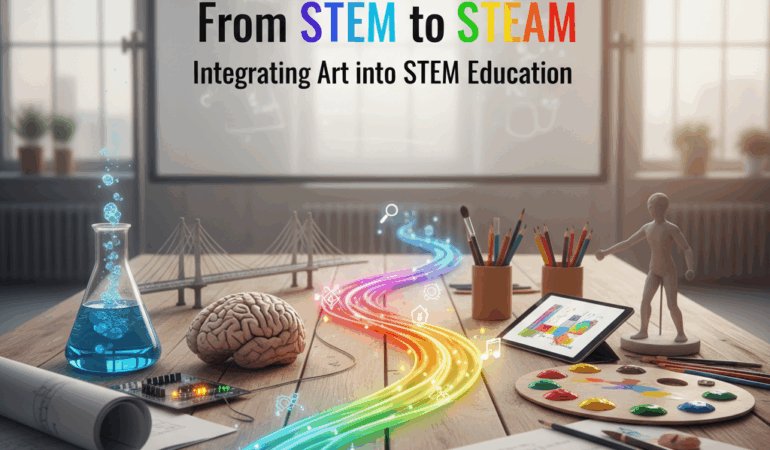
From STEM to STEAM: Integrating Art into STEM Education
Course Description
This course aims to teach educators how to integrate art (A) into the STEM (Science, Technology, Engineering, and Mathematics) disciplines, transitioning from STEM to STEAM. By incorporating art, students can enhance their creativity, improve problem-solving skills, and experience interdisciplinary learning that connects both scientific and artistic competencies. This course aligns with the 2021-2027 Erasmus+ Programme‘s priorities of digital transformation and inclusivity, offering a unique opportunity to develop innovative educational approaches.
Participants will learn how to design lesson plans and activities that integrate art into STEM disciplines, encouraging students to explore both their artistic and scientific talents. The course will also focus on using digital tools and creative methods to make STEM subjects more engaging.
Course Methodology
The course is based on an activity-based, hands-on, and collaborative methodology. Educators will first learn the theoretical aspects of how ICT can be integrated into language teaching and will then engage in classroom applications using various digital tools and methods. Each day, participants will have the opportunity to develop their skills through group work, individual projects, and technology-supported activities. The course is designed to ensure that participants can easily transfer their learning into their own teaching environments.
Course Methodology:
The course is based on an activity-based, hands-on, and collaborative methodology. After gaining theoretical knowledge on the STEAM education model, participants will develop lesson plans and projects that demonstrate how art can be integrated into STEM education. Digital tools and projects will support this integration, and daily group work, collaborative activities, and creative problem-solving tasks will be emphasized.Participants will transform their learning into practical projects that they can implement in their own schools.
Course Objectives
- To teach educators how to apply the STEAM model by integrating art into STEM subjects.
- To create interdisciplinary learning environments that foster creativity, problem-solving skills, and critical thinking.
- To develop innovative lesson plans and projects that use digital tools to bridge the gap between art and STEM.
- To design educational programs aligned with the inclusivity and digital transformation priorities of Erasmus+.
Learning Outcomes:
By the end of this course, participants will:
-
- Be able to create lesson plans based on the integration of art and STEM.
- Design creative and interdisciplinary learning environments using the STEAM model.
- Develop projects that combine art and STEM using digital tools and methodologies.
- Create STEAM-based learning environments that support the implementation of Erasmus+ priorities in digital transformation and inclusivity in their schools.
Tentative Daily Programme
Day 1: Introduction to the STEM and STEAM Models
- Icebreaker Activity: “Let’s Dream and Connect Together”
- Participants share their experiences and expectations related to art and STEM.
- STEM and STEAM Education Models: Key Concepts
- An overview of the STEM and STEAM concepts and how art can be integrated into STEM.
- Benefits of the STEAM Model
- The impact of the STEAM model on student success and how it can transform learning environments.
- Project Simulation: Designing a STEAM-Based Lesson Plan
- Participants design creative lesson plans that integrate art into STEM disciplines.
Day 2: Fostering Creativity and Interdisciplinary Learning
- Warm-up Activity: “Creativity in STEAM Activities”
- Participants discuss how creativity can be integrated into STEAM activities.
- Creative Problem-Solving Techniques
- The role of art in developing problem-solving skills and how it can be integrated into STEM.
- Interdisciplinary Learning Strategies
- How to create interdisciplinary learning environments and their relation to STEAM.
- Project Presentations and Feedback
Day 3: Enhancing STEAM Education with Digital Tools
- Warm-up Activity: “The Intersection of Digital Art and STEM”
- Participants explore how digital tools can bring art and STEM together.
- Digital Tools for STEAM Education
- Using tools like Tinkercad, Scratch, and Google Arts & Culture to enhance STEAM education.
- The Role of Technology and Art in STEM Education
- How to make STEM education more engaging by incorporating digital tools and art.
- Project Presentations and Feedback
Day 4: Designing STEAM-Based Projects
- Methods for Developing STEAM Projects
- Project-based learning methods and their applications in STEAM education.
- The Role of Art in STEAM Education
- The importance of art in fostering creativity and problem-solving in STEM education.
- Group Project Presentations and Feedback
Day 5: Course Evaluation and Certification Ceremony
- Course Evaluation
- Participants reflect on their learning and discuss collaboration opportunities.
- Future Collaboration Opportunities for STEAM Education
- Participants discuss opportunities for collaboration on Erasmus+ projects focused on STEAM education.
- Certification Ceremony and Course Cake Cutting
- Cultural Excursion Support
At the End of the Course
- Participants will receive their certificates.
- Participants will provide a general evaluation of the course and complete the event survey.
- Participants will receive course materials, videos, photos, and PDF documents in both digital and print formats.
Follow-up and Support
After the course, participants will be provided with digital and printed materials. An email group will be created to facilitate ongoing collaboration and the sharing of ideas related to digital language teaching projects.
*Please note that course activities and content may vary depending on participants’ preferences and the instructor leading the session. Any changes to the course are at the discretion of the instructor. If there is a specific topic you would like to include in the course content, please let us know in advance.
Course Info
- Duration: 5 Days
- Location: All Location
- Cost: € 80-Day
- Certificate: Yes
- Prerequisites: No



